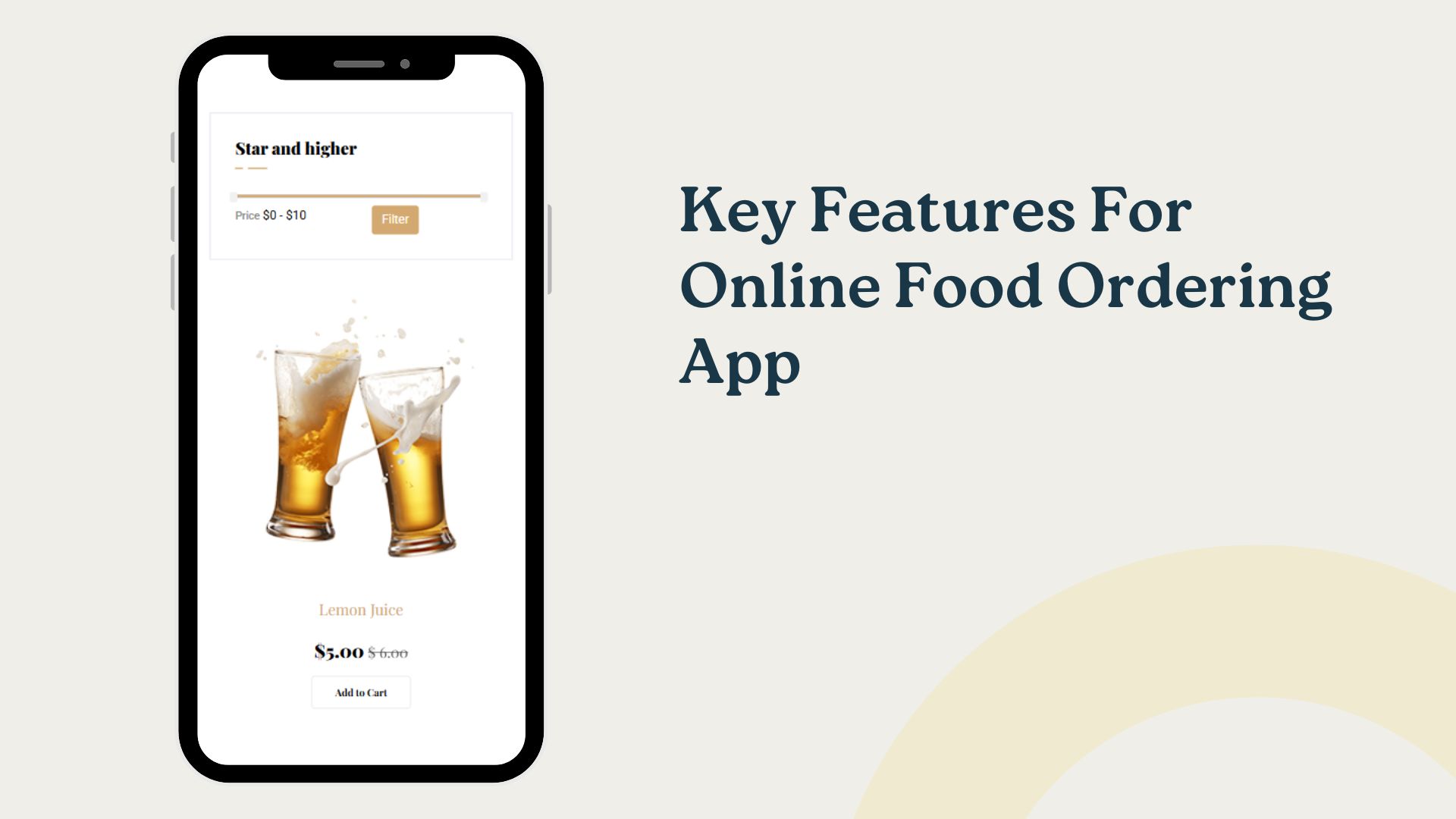11 Essential Features For Online Food Ordering App


The global online food delivery market is booming, with revenue projected to hit $1.39 trillion in 2025—growing at 7.64% annually to reach $2.02 trillion by 2030 (Statista). With apps like Uber Eats, DoorDash, and Zomato dominating the space, consumers now expect seamless ordering at their fingertips.
A complicated sign-up process can drive potential users away. Research shows that 23% of users abandon an app after one use if registration is tedious (Localytics). To prevent this:
Offer multiple sign-up options (email, phone number, Google, Facebook).
Enable guest checkout so users can order without creating an account.
Minimize form fields—only ask for essential details initially.
Optimize UI/UX with intuitive icons, clear CTAs, and a clutter-free layout.
Apps like Swiggy and Grubhub excel in this by allowing quick sign-ins via Google or Facebook, reducing friction for first-time users.
Once users sign up, they should be able to:
Save multiple delivery addresses (home, office, etc.).
Set dietary preferences (vegetarian, vegan, gluten-free).
Manage payment methods (credit cards, UPI, PayPal).
Track order history for easy reordering.
A study by Baymard Institute found that 35% of users abandon carts if forced to create an account. Allowing profile customization without mandatory logins improves retention.
Hungry customers want to find food fast. Implementing robust search functionality helps:
Auto-suggestions (e.g., “pizza near me”).
Filters (price range, cuisine, delivery time, ratings).
Voice search (used by 40% of adults daily, according to Google).
Zomato’s advanced filters let users sort by “pure veg,” “top-rated,” or “fast delivery,” enhancing user experience.
Your app should work seamlessly across:
iOS & Android (covering 99% of mobile users).
Web browsers (for desktop users).
Progressive Web Apps (PWAs) for offline access.
A Google study found that 53% of users abandon sites if they take over 3 seconds to load. Optimizing for all platforms ensures no customer is left behind.
A well-organized menu increases conversions:
High-quality images (apps with good visuals see 30% more orders).
Detailed descriptions (ingredients, allergens, spice levels).
Real-time availability to avoid order cancellations.
Domino’s Pizza uses an interactive menu with customization options (extra cheese, toppings), boosting engagement.
Payment flexibility is key—56% of users abandon carts if their preferred payment method is missing (Baymard Institute). Ensure:
Multiple options (credit/debit, UPI, PayPal, COD).
One-click payments for returning users.
PCI-DSS compliance for security.
Uber Eats allows Apple Pay, Google Pay, and card payments, reducing checkout friction.
Customers want to know:
Where their order is (live GPS tracking).
When it will arrive (ETA updates).
Who’s delivering (driver details).
A Zendesk report found that 83% of customers expect real-time order tracking. Apps like DoorDash provide a map view, increasing transparency.
Social proof drives trust:
Star ratings & written reviews help users choose restaurants.
Restaurant responses show engagement.
Photo reviews (users trust visuals 12x more than text).
Yelp’s data shows that 90% of diners read reviews before ordering.
Leverage social platforms for growth:
Social logins (faster sign-ups).
Sharing orders (free marketing).
Referral discounts (e.g., “Get $10 off for inviting friends”).
Postmates grew rapidly by incentivizing social shares with discounts.
Quick issue resolution prevents churn:
In-app chat/call support.
FAQ section.
AI chatbots for instant help.
A Microsoft study found that 90% of users expect immediate responses.
Retain customers with:
Discounts & cashback (e.g., “10% off next order”).
Points system (redeemable for free meals).
Birthday/anniversary offers.
Starbucks’ loyalty program drives 40% of their revenue—proving incentives work.
Developing a food delivery app from scratch is a complex, time-consuming, and expensive process. Traditional development requires 6+ months of work and costs $50,000 or more, covering UI/UX design, backend development, payment integrations, and testing. Zipprr’s ready-made food delivery solution eliminates these hurdles, allowing you to launch a fully functional app in days instead of months—at a fraction of the cost.
1. Pre-Built Core Features
Zipprr’s solution comes with all the essential features already integrated, including:
Seamless ordering system with cart management
Real-time GPS tracking for deliveries
Multiple payment gateways (credit/debit, UPI, e-wallets, COD)
Customer reviews & ratings for transparency
Push notifications for order updates
Admin, restaurant, and delivery partner dashboards
This means you don’t have to spend months coding these features—just customize and deploy.
2. Free Server Setup & App Submission
Setting up cloud servers, databases, and security protocols is a technical challenge. Zipprr handles:
Server installation & configuration (AWS, Google Cloud, or Azure)
App store submissions (Google Play & Apple App Store)
App resubmissions if updates are required
This ensures a smooth, hassle-free launch.
3. Scalable Infrastructure
As your business grows, your app must handle increasing orders without crashes. Zipprr’s solution is built on cloud-based, auto-scaling architecture, ensuring smooth performance even during peak demand.
4. Complete Brand Customization
Your app should reflect your brand identity. With Zipprr, you can:
Add your logo, brand colors, and fonts
Customize the UI/UX to match your style
Use your own domain name
5. Cost & Time Savings
Instead of spending months and thousands of dollars on development, Zipprr lets you launch in days with a proven, market-ready solution. This gives you a competitive edge, allowing you to focus on marketing and customer acquisition rather than technical hurdles.
The food delivery industry is booming, projected to hit $2.02 trillion by 2030—but success demands a feature-packed, user-friendly app. With Zipprr’s ready-made solution, you skip the costly, time-consuming development process and launch a scalable, branded food delivery app in days.
Monacgo: 7/1253 Subramania Siva Street, NGO colony, Nagamalaipudukottai, Madurai – 625019, Tamil Nadu, India.
Mobile: +91 9789308131
Monacgo: 403 Starkweather Ave, Cleveland, OH 44113, United States
Mobile: +1 (585) 632-0256
Email: support@zipprr.com
Disclaimer: The keywords Gojek, Airbnb, Uber, UberEats, UrbanClap, Amazon, Carousell, ChatGPT, Youtube, Facebook, Turo, Practo, TaskRabbit, TikTok, Udemy, Whatsapp, Tinder and Letgo are solely used for marketing purposes, and we are not associated with any of the mentioned companies in any form. The source code and design of our products are fully owned by sellers. We are not using any of their copyrighted materials.
© 2025 Zipprr. All rights reserved.
